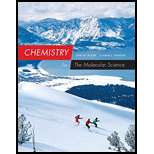
Interpretation:
The mass of chloroform and
Concept Introduction:
Explanation of Solution
The polymer Teflon is formed by the addition reaction of tetrafluoroethylene.
Consider the given reaction as follows.
From the above reaction, one mole of tetrafluoroethylene gives one mole of Teflon. The molar mass of tetrafluoroethylene and teflon is same. Therefore,
Conversion of kilograms to grams is as follows.
The molar mass of tetrafluoroethylene is
Use the following expression for moles of a compound.
Substitute
Consider the reaction for the formation of tetrafluoroethylene.
From the given reaction,
Consider the given reaction as follows.
One mole of
The molar mass of
Use the following expression to calculate the amount of
Substitute
One mole of
The molar mass of
Use the following expression to calculate the amount of
Substitute
Therefore, for preparing
Want to see more full solutions like this?
Chapter 10 Solutions
Chemistry: The Molecular Science, Loose-leaf Version
- Heptane, C7H16, can be catalytically reformed to make toluene, C6H5CH3, another seven-carbon molecule. How many hydrogen molecules are produced for every toluene molecule derived from heptane? Write a balanced chemical equation for this reaction. Why is it profitable to convert heptane into toluene?arrow_forward3.89 Pyridine has the molecular formula C5H5N. When pyri- dine reacts with O2, the products are CO2, H2O, and N2. Write a balanced equation for this reaction.arrow_forwardUse the web to research the amount of PVC polymer produced annually in the United States. What are the three most common uses of this polymer?arrow_forward
- Cloth can be waterproofed by coating it with a silicone layer. This is done by exposing the cloth to (CH3)2SiCl2 vapor. The silicon compound reacts with OH groups on the doth to form a waterproofing film (density = 1.0 g/cm3) of [(CH3)2SiO]n, where n is a large integer number. n (CH3)2SiCl2 + 2n OH 2n Cl + n H2O + [(CH3)2SiO]n The coating is added layer by layer, with each layer of [(CH3)2SiO]n being 0.60 nm thick. Suppose you want to waterproof a piece of doth that is 3.00 square meters, and you want 250 layers of waterproofing compound on the cloth. What mass of (CH3)2SiCl2 do you need?arrow_forwardIn an experiment, 23 g of ethanol (C2H5OH) reacted with an excess of ethanoic acid (CH3COOH) and 33 g of the product ethyl ethanoate (CH3COOC2H5) was obtained. Calculate the % yield for the reaction (balanced equation given below). C2H5OH + CH3COOH → CH3COOC2H5 + H2Oarrow_forwardAnswer the following questions. 1. What are the benefits of green chemistry?2. How can non-beneficial chemical reactions be minimized and stopped?3. Discuss how chemical engineering applies the concept of limiting reagent and excess reagent in a reaction.arrow_forward
- In four or more sentences, explain the advantages of using biodegradable plastic.arrow_forwardFill in the missing reactant or reagent or product to bring about the following chemical reactions.arrow_forward5. The goal is to convince an investor to invest in your company so that you can build a factory to make ester compounds. For example, you could make hexyl pentanoate, and sell it for use in perfumes and make the investor money. You must come up with a compound that you can make and sell. You can use your textbooks and the internet as resources. At the end of your research, you must have the compound table filled out.arrow_forward
- The organic lab program generates around 200 liters of non-halogenated organic waste every week. A student accidentally added some halogenated organic waste to a waste container that entered the non-halogenated waste stream. The cost to dispose of 1.000 liter of non-halogenated organic waste is $20.27 The cost to dispose of 1.000 liter of halogenated organic waste is $89.71 Due to the error, how much extra money will it cost to dispose of 210.9 liters of the waste that week?arrow_forward1. Why perform product stability? 2.What are the factors that affect a product’s stability during its shelf life? 3. What are the suggested conditions/temperatures a product should be exposed under in order to determine its stability?arrow_forwardHow do you solve this from start to finish? A monolayer containing 3.21 × 10 –6 g of oleic acid has an area of 20.0 cm 2. The density of oleic acid is 0.895 g / mL. What is the thickness of the monolayer (the length of an oleic acid molecule)? a. 1.79 × 10¯7 cm b. 1.44 × 10¯7 cm c. 5.75 × 10¯5 cm d. 5.58 × 10¯6 cm e. 7.17 × 10¯5 cmarrow_forward
 Chemistry: The Molecular ScienceChemistryISBN:9781285199047Author:John W. Moore, Conrad L. StanitskiPublisher:Cengage Learning
Chemistry: The Molecular ScienceChemistryISBN:9781285199047Author:John W. Moore, Conrad L. StanitskiPublisher:Cengage Learning Chemistry & Chemical ReactivityChemistryISBN:9781133949640Author:John C. Kotz, Paul M. Treichel, John Townsend, David TreichelPublisher:Cengage Learning
Chemistry & Chemical ReactivityChemistryISBN:9781133949640Author:John C. Kotz, Paul M. Treichel, John Townsend, David TreichelPublisher:Cengage Learning Chemistry & Chemical ReactivityChemistryISBN:9781337399074Author:John C. Kotz, Paul M. Treichel, John Townsend, David TreichelPublisher:Cengage Learning
Chemistry & Chemical ReactivityChemistryISBN:9781337399074Author:John C. Kotz, Paul M. Treichel, John Townsend, David TreichelPublisher:Cengage Learning Chemistry for Engineering StudentsChemistryISBN:9781337398909Author:Lawrence S. Brown, Tom HolmePublisher:Cengage Learning
Chemistry for Engineering StudentsChemistryISBN:9781337398909Author:Lawrence S. Brown, Tom HolmePublisher:Cengage Learning Chemistry for Engineering StudentsChemistryISBN:9781285199023Author:Lawrence S. Brown, Tom HolmePublisher:Cengage Learning
Chemistry for Engineering StudentsChemistryISBN:9781285199023Author:Lawrence S. Brown, Tom HolmePublisher:Cengage Learning





